From short films to documentaries, diaCritic Jade Hiddle presents an in-depth review of the films featured in the 2013 San Diego Asian Film Festival.
Have you subscribed to diaCRITICS yet? Subscribe and win prizes! Read more details.
This year’s annual San Diego Asian Film Festival took place from November 7th to the 16th and was larger than it has ever been. Still headquartered at the Digiplex in Mission Valley, the festival has also spread to new locations all across the county, including the big, fancy, futuristic new library downtown. (How nice it is to see time and money invested in a library of all things in this day and age). As has been the case in the past few years that I have been attending SDAFF, the coordinators, staff, volunteers, and filmmakers were so friendly and genuinely excited to be part of the event. All week, the Digiplex was buzzing with a sense of community and enthusiasm for Asian and Asian American filmic arts. Notable about this year was an influx of short films, one of which will most likely be the festival’s last 35 mm screening, reflecting the changing face of the film genre and industry.
Another change to this year’s program of 140 films was that only a few submissions featured Vietnamese or Vietnamese American filmmakers and actors. The only work from Viet Nam was a short film titled “The Man in the Fish Pool.” Le Lam Vien and Do Nhu Trang’s film was part of a screening of a cluster of shorts tethered by the theme “All Out of Love.” Appropriately, this Vietnamese submission focused on a writer-translator character whose pet problems—a belly-up (then replaced) goldfish and a lost (then found) pink-tongued cat—symbolize the protagonist’s troubles in love. Initially it seemed as though the fish and the cat stood in for a lost lover who was as absent as the missing cat. I wondered, is she dead? Or, how did they break up? There was a tension to not knowing. But only for a short while. After the writer buys a new goldfish, he returns to the apartment to find the front door ajar. Speculations raced through my head in the dark theater—the returning (perhaps vengeful) ex? A ghost? A robber or murder? An angry editor? I soon realized, though, that these speculations, some feasible but most incongruous with the tone of the film, indicated my craving for conflict. And the film did not deliver. Turns out that his significant other was just away working as a flight attendant. The couple’s reunion is represented by a series of shots of the whirring ceiling fan, sweating glasses of water, the woman’s nail polish, the swimming fish, the lovers in bed.

The voice over is equally art house—for example, “A silent world that drives people insane.” On the one hand, I certainly recognize the merit of a Vietnamese film attending to the daily, domestic realities in contemporary Viet Nam with realistic performances by actors who look like normal human beings. (The poreless skin and superhuman proportions of some of the Taiwanese and Korean actresses populating the works at the festival made me grateful to be able to hide my face in the darkness of the theater and I actually discarded half of a box of chocolate-covered raisins—I know, blasphemy—while watching a ninety-pounder float across the screen.) On the other, the lack of conflict limited my investment in the characters and the narrative as a whole. I was left largely unsatisfied, and interestingly enough as soon as the credits began to roll the audience rippled with murmurs. Of those I overheard, the viewers were most taken with the feline actor, and the comments that were more difficult to distinguish echoed with the lilt of questions, perhaps also searching for satisfaction.
“The Man in the Fish Pool” was quickly overshadowed by the short films that followed it, especially “Plan B,” an “abortion comedy” (in the words of the director), with notably funny and realistic performances from Randall Park and Rosa Salazar. But the greatest unexpected pleasure of this short film screening was “Samnang,” named for the protagonist who is a widowed Cambodian donut baker working in Cambodia Town (straight outta Long Beach, my hometown!). Revolving around a powerful performance by Jonathan Nitasneak Dok, “Samnang” traces a simple but an emotionally-wrought narrative about labor and love, screenplay by Vanara Taing. Never have twist donuts been so sexually charged. The film also showcases cultural encounters through music, traditional Cambodian songs juxtaposed with hip-hop beats, and, of course, the underappreciated art of the glorious donut.
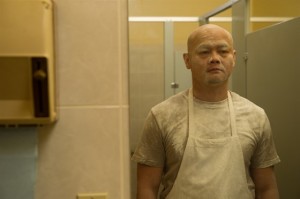
Vietnamese American filmmaker and UCSD alum Byron Q had another feature in this year’s festival. In 2011, he submitted Bang, Bang, a fictional film about Asian American gangsters in San Diego, showcasing a good performance by the Vietnamese American rapper Thai Viet G. This year, Byron Q presented a documentary called Raskal Love, which focused on telling the life of Vanna Fut, a member of the Tiny Raskals Gang (TRG), who served as a consultant for Bang, Bang. I was interested to see Byron Q’s take on the documentary, especially on a topic that is underrepresented or, when represented, mere shadows of iconic ‘90s films like Boyz in the Hood or Menace to Society. It seemed others were interested too because I was joined at the screening by the youngest, most energetic audience I saw at the festival, though it was the smallest.
However, within the first few minutes of the film, I was put off by the tone and style of the documentary. It came off more like a History Channel show or a Behind the Music special. But with gangbangers. Rather than allowing a narrative to emerge from the interviews, Bryon Q imposed a voiceover that rings like a forced historical throughline, cut to stock footage that detracted from the specificity of Vanna’s story, and included rather cheesy and excessive reenactments of events that are very serious in terms of gang violence, domestic abuse, and racial discrimination. The stylistic choices distracted from Vanna’s compelling life story. It seemed, too, that the film was more about glorifying Vanna than digging into gang life. Raskal Love was, for lack of a better word, an odd viewing. Though Byron Q has his heart in telling important stories, he is still apparently developing his style and learning the special art that is the documentary genre.
The greatest triumph for Vietnamese Americans at the film fest, I believe, was the appearance of Dat Phan (maybe you remember him as the winner of Last Comic Standing) in Sake-Bomb, directed by fellow Cal State Long Beach alum (Go Beach!) Junya Sakino. An Asian American take on the conventional Hollywood road trip flick, the film follows rural Japan-born Naoto (Gaku Hamada) as he visits his Los Angeles-raised cousin Sebastian, and the two embark on a road trip to track down Naoto’s long lost love in the Bay Area. I initially attended this screening because I was curious about the short film that preceded it, The Curious Case of Tommy Do, which turned out to be a familiar type of student art film—the spinning of a laundry cycle encapsulates the tacit, mundane routine of the eponymous protagonist as he picks at a disappointing Banquet TV dinner, indecisively peruses the hundreds of options in the chip aisle of the grocery store, and lazes on the couch. Curious Case’s contrived effort to capture the malaise of a young Vietnamese American man’s life left me wanting. But not for long. From first to last frame, Sakino’s Sake-Bomb clearly exhibited why it won the SDAFF award for Best Narrative Feature Film. Sake-Bomb energized the packed theater with its well-paced narrative punctuated by humor and heart, all the while making relevant, warranted social commentary on representations of Asian and Asian American identity in mass media and pop culture.
The film tackles the cultural conflicts arising between Asians and Asian Americans. In the vein of many Asian American YouTube filmmakers (Just Kidding Films, Wong Fu Productions, David So, Niga Higa, just to name a few), Sebastian’s character runs a blog site called “FOB Motherfucker” where he rails against the pervasive stereotypes of Asians, from the emasculation of Asian men to the lumping together of all Asian groups. The film focuses largely on the lack of representation and emasculation of Asian American men.
From the opening scene of erection talk to the various humorous and heartbreaking encounters with lovers, Sake-Bomb illustrates the fetishization of male Asians and Asian Americans (it doesn’t just happen to women), and the self-hatred that can be fostered in such relationships, however deftly cloaked as Sebastian’s initially attempt to be. The most memorable example of one form of Asian American male sexuality is Dat Phan’s portrayal of Vietnamese refugee turned porn star named Long Wang. He illustrates the long-standing stereotypes of Vietnamese as perpetual foreigners and model minorities as he plays a heavily accented and unknowing student in a porno where he is “taught a lesson” by his busty, white co-star.
Later, we learn that Long Wang’s real-life was marked by drinking, depression, and poverty. Dat Phan’s humorous performance stands as a pornographic cautionary tale about prescribed sexual roles for Asian Americans. Sebastian and Naoto still end up without the girl, as it happens in Hollywood movies, but at least Sake-Bomb addresses why by making Asian male characters the protagonist, rather than just the martial artist sidekick. Over the course of the film, Sebastian learns from Naoto how to reassess his own Asian American assumptions about Asians. In the Q & A period following the screening, Sakino discussed how this tension stemmed from his own experience of coming from his native Japan to study in the U.S. and discovering Asian Americans’ parallels and divergences from his own Asian identity. The film does feel very realistic and, though it kept the audience cracking up all along the way, it bears a very powerful message for young Asian and Asian Americans about acknowledging the ability, the necessity, to be angry, but also the understanding of when and why to let it go.
Beyond Vietnamese works, there are a couple of films I would like to highlight. Byron Q could learn a few things about documentary filmmaking from the compelling and inspiring works featured throughout the festival.
Touted as only the third standing ovation in the fourteen-year history of the SDAFF and winner of the best documentary award at this year’s Los Angeles Asian Pacific Film Festival, veteran documentarian Jason DaSilva’s When I Walk chronicles the progression of the director’s very own Multiple Sclerosis, from the moment he first lost control of his leg muscles in a home video of a family vacation to the ensuing seven years of struggles with rapidly decreasing mobility, family, love, sex, parenthood, and, most prominently of all, how his debilitating disease forces him to adapt to new methods of filmmaking.
In this way, the documentary is quite self-reflexive as we see DaSilva and his wife working together to compile and edit footage of the very story of MS that they are living. Da Silva narrates, “It is difficult to know where our stories are going as they’re being written.” He certainly captures those difficulties in heartwrenching ways (to the extent that in certain moments I experienced a powerful urge to pump my legs in a quick run, to hug my mother, and to make a baby with my man), but at the same time DaSilva makes the filmmaking process look easy, as the documentary is so artfully constructed, complete with transitions fashioned from his comic book art.
Also moving was Hafu documenting the testimonies of five “mixed roots” individuals living in a largely homogenous, but increasingly diverse, contemporary Japan. The documentarians Megumi Nishikura and Lara Perez Takagi chose their subjects well to represent a diverse array of experiences of being mixed. Some come to Japan while others leave to find their respective senses of self, while still others attempt to navigate the shifting terrain of identity within Japan. The subjects also represent diverse ethnic and cultural minglings—Venezuelan, Mexican, White Australian, Ghanan, and Korean, the latter of which speaks to the majority of mixes in Japan that are inter-Asian and the discrimination and segregeation of zainichi Koreans living in Japan. A concerted effort to complicate the exoticization and reductive celebration of mixed heritage individuals, the documentary focuses on the division, self-hatred, discrimination, and the perpetually tense negotiation of culture, ethnicity, and nationality, which is pronounced in Japan because of its stringent policies on claiming nationhood.
Alex, the son of a Mexican mother and Japanese father, represents the challenges to raising a multicultural, multilingual child. This sweet boy will break and make your heart. The filmmakers’ decision to include a child’s perspective of forging cultural identity was resonant, especially as the other interviewees are adults reflecting back upon their experiences growing up mixed. Alex reminds us of the sharpness of the first encounters with racism early in life, from lunch time to the playground, and the earnest victories of overcoming those challenges, or at least learning how to manageably incorporate them into who you want to become. The diverse range of personal stories in this documentary offer everyone a slice of life with which they can identify.
Though the film largely narrates the struggles involved with tracing mixed roots, ultimately, with the help of the endearing character and movie star-caliber smile of David, the Ghanan-Japanese man, the film ends on a positive note. David concludes that the questions he constantly encounters are worth answering because doing so will make life easier for future generations of mixed roots individuals. That hope for the future feels secured by David’s charity to build schools in his mother’s home of Ghana and Venezuelan-Japanese Edward’s non-profit organization Mixed Roots. The positive work that these individuals do and what the film aspires to do by foregrounding these personal stories before outlining Japan’s demographic statistics as the credits roll is revealed to be all the more important when the post-screening Q & A session fields a question expressing concern about the high birthing rates of immigrants, and thus rates of miscegenation, in the U.S. One of the directors, Megumi Noshikura, answered this question (in addition to all the other, non-offensive inquiries) with grace and eloquence, and I fully support her patient efforts to cultivate tolerance through her film.
Finally, another Asian American use of film as a tool for education and activism is Plastic Paradise: The Great Pacific Garbage Patch, directed by Los Angeles-based filmmaker Angela Sun. This film documents Sun’s seven-year investigation into the bigger-than-Texas (literally) buildup of plastic debris/waste in the Midway Atoll, known as the Great Pacific Garbage Patch. This film is important because so often Asians are associated with detrimental impacts on the environment, from Chinese factory pollution to overfishing in Japan, and here Sun is fighting to save the Pacific Ocean, the space where Asia and America converge, albeit through histories of war. And trash.
Sun makes for an earnest and engaging guide through the bureaucratic red tape and corporate corruption obscuring the massive environmental issue, as well as the journey to the GPGP where Sun’s filmmaking team collects disturbing footage of Midway Atoll park rangers dissecting albatross carcasses that, when cut open, overflow with plastic debris.
In addition to the rangers and activists working at the front lines of this ecological warfare, Sun interviews sustainability scholars, euphemism-blabbing corporate suits, and consumers, whose daily use of plastic, coupled with their lack of education about its production and impacts, are complicit in the problem. Sun provides useful visuals for understanding not only how 1950s-era, tobacco industry-esque propaganda continues to propel our consumption with plastics that are designed to live forever but to be disposed of after only one use, but also the concrete consequences to nature’s ecological systems and our health.
Sun’s most compelling argument was delivered through a before-and-after blood test that revealed how BPA (commonly associated with plastic bottles) on receipt paper is absorbed through the skin and into the bloodstream, a bodily contamination that could contribute to early onsets of puberty in girls and various cancers. In the Q & A period following the screening, Sun put a fine point on consumers’ responsibility to follow through with the film’s mission: to use our dollars to cast a vote in favor of our environment and future. We can limit our use of plastic bottles and bags, buy in bulk, and ultimately reduce our imprint on the GPGP and the contamination of our world, our bodies. First-time filmmaker Sun is admittedly still learning how to navigate the channels of distribution, but she hopes to have the film available online and/or DVD in the near future. When it comes out, buy it. But don’t touch the receipt.
All in all, this year’s SDAFF was inspiring, namely in its channeling of the filmic arts into social activist efforts. The festival was extended an extra day to raise money for victims of the devastating storm in the Philippines. SDAFF, and the Pacific Arts Movement that organizes it, are worthy causes to support because they foster a sense of community amongst Asians, not only here, but across the world. It is refreshing to be around people who see art’s capacity for change, which was all the more resonant for me after a day of teaching students that literature and art and film (not just the latest Jackass movie) are worth a damn. With 140 options to choose from, the SDAFF makes every viewer’s experience unique. After the 10+ screenings I attended, several of which I did not have the space to discuss here, I still wanted to see more. SDAFF makes me want to go out and do and live and create.
Jade Hidle is a Vietnamese-Irish-Norwegian writer and educator. She holds an MFA in creative writing from CSU Long Beach and is working on a PhD in literature at UC San Diego. Her work has appeared in Spot Lit, Word River, and Beside the City of Angels.
Do you enjoy reading diaCRITICS? Then please consider subscribing!
Please take the time to rate this post (above) and share it (below). Ratings for top posts are listed on the sidebar. Sharing (on email, Facebook, etc.) helps spread the word about diaCRITICS. And join the conversation and leave a comment! What did you think of the author’s commentary on these films? Do you agree with her take on these films? Tell us what you think! We want to know! If you haven’t seen any of these films, were there some films discussed in this article that you are now interested in seeing?





